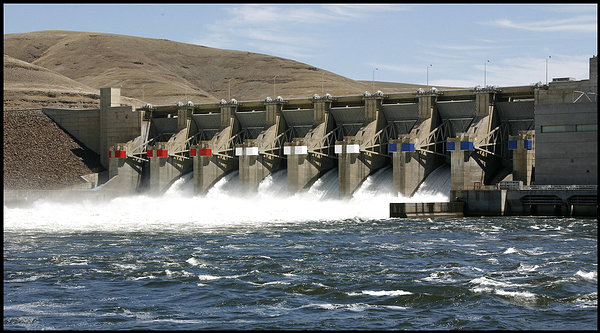forum
library
tutorial
contact

10 Years After Installation,
Fish Slide at Ice Harbor Celebrated
by Annette Cary
Tri-City Herald, July 15, 2015
|
the film forum library tutorial contact |

|
10 Years After Installation,
by Annette Cary
|
"Ten years ago when the first weir was installed the idea that fish,
commerce and power could coexist was not as clear as it is today,"
 A decade after a fish-friendly water slide was installed at Ice Harbor Dam on the Snake River near Burbank, officials celebrated Wednesday the success of such structures on the lower Columbia and Snake Rivers.
A decade after a fish-friendly water slide was installed at Ice Harbor Dam on the Snake River near Burbank, officials celebrated Wednesday the success of such structures on the lower Columbia and Snake Rivers.
"The spill weirs in many ways are a sort of poster child in intelligent investing in helping salmon pass through the system," said Elliot Mainzer, administrator of the Bonneville Power Administration.
Improving fish survival allows the dams to continue to be used to benefit the region -- producing low-cost hydropower, allowing the barging of Northwest goods to the coast for export and providing recreation, said speakers at the anniversary event.
"Ten years ago when the first weir was installed the idea that fish, commerce and power could coexist was not as clear as it is today," said Rob Rich, president of the Columbia River Towboat Association. "The improved fish numbers we have seen in the last 10 years have more than proven this was the right step to take."
In the 1990s the survival rate of fish traveling downstream past dams was in the upper 80 percent to low 90 percent, said Rock Peters, senior fish program manager for the Army Corps of Engineers.
The most recent study at the 2-million-pound spillway weir installed at Ice Harbor showed 98 percent of fish survived and 98 percent of the fish passed through uninjured to the downstream side of the dam, said Kenneth Fone, the Army Corps fisheries biologist for the project.
Ice Harbor was the first dam in the region to have a spillway weir installed, after a prototype was tested at Lower Granite Dam. Improvements were made for the weirs installed at Ice Harbor in 2005 and Lower Monumental Dam two years later.
Before that juvenile salmon and steelhead heading to the ocean at depths of 10 to 20 feet would have to dive down to 50 to 60 feet to find spillway gates that allowed them to move past the dams, said Lt. Col. Timothy Vail, commander of the Walla Walla District of the Corps.
The fish water slides allow juvenile salmon and steelhead to slip along with surface water and then go down the slide, coming out on the downstream side of the dams headed toward the ocean.
It's "very passive," said Kevin Crum, Corps project manager, and doesn't leave fish disoriented or injured.
Migration delays at the dams are reduced.
Historically fish swam for 12 to 15 days to get from where Lower Granite Dam now stands near Pomeroy to the estuary of the river. When the dams went up that increased to 20 to 30 days.
But the spillway weirs are helping fish find their way past each dam in as little as an hour, down from as much as a day, said Corps officials.
Fish are on a biological clock that requires them to make it to the estuary while they are still capable of transitioning from fresh to salt water. If they arrive late, their survival rate declines, said Rob Lothrop of the Columbia River Inter-Tribal Fish Commission.
Hanging out above the dams also is dangerous to their survival. Predators from cormorants to other fish can pick them off there.
Over the last decade eight Corps dams on the lower Columbia and Snake rivers have had technologies installed that provide less stressful fish passage routes near the surface of the water.
Lower Granite, Lower Monumental and Ice Harbor dams each have a removable spillway weir attached to the upstream side of the dams and fitted into spillways to raise them to salmons' preferred depth.
Second-generation spillway weirs were installed from 2007 to 2009 at McNary and John Day dams on the Columbia River and Little Goose Dam on the Snake River. Surface bypass channels are used at Bonneville and The Dalles dams on the Columbia River.
It's part of the largest fish-conservation initiative in the nation, according to the Corps. It has contributed to record fish runs in the Columbia Basin, including the Snake River, in recent years.
"There is still a lot of work to be done," Vail said. "But the outlook for fish has improved significantly in the last decade in part due to spillway weirs on the dams."
In the next few years the Corps plans to outfit Ice Harbor Dam with turbines designed for safer fish passage, he said.
learn more on topics covered in the film
see the video
read the script
learn the songs
discussion forum
